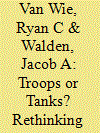| Srl | Item |
| 1 |
ID:
141785


|
|
|
|
|
| Summary/Abstract |
The formal model of modern-system force employment developed in Stephen Biddle (2004) book, Military Power, is a standard text in the defense analysis field but has rarely been applied to analyze battlefield outcomes. The 2008 Five-Day War between Russia and the Republic of Georgia provides a compelling case study for empirical testing. The outcome of the conflict reveals an inconsistency between the theoretical model and the actual results, suggesting that technical and tactical force employment variables alone may not be sufficient to explain battlefield dynamics, and that the effects of psychological shock on unit morale and cohesion may constrain how well a military force can perform even while adhering to modern-system doctrine.
|
|
|
|
|
|
|
|
|
|
|
|
|
|
|
|
| 2 |
ID:
153175


|
|
|
|
|
| Summary/Abstract |
Although hundreds of thousands of soldiers from different national contingents are deployed every year in multinational peace operations, no previous study has examined differences in peacekeeping practices along national lines. This paper first documents systematically differences in the way national contingents behave during peace operations in their respective area of operation. In a second step, it argues that these differences in behavior are largely consistent with the most important traits of each army's military culture. Based on extensive fieldwork conducted between 2007 and 2014 in Lebanon and Afghanistan, the paper shows how, within each mission, Italian soldiers prioritized humanitarian activities, while the French engaged in more patrolling activities, despite being both contingents deployed under similar conditions. These variations in behavior are consistent with the way French and Italian soldiers perceive the mission and context in which they deployed. And both the differences in behavior and perception are in line with the respective armies' military cultures. This paper contributes to the debate on the role of ideational factors in international politics and in particular to the ongoing discussion on strategic and military cultures.
|
|
|
|
|
|
|
|
|
|
|
|
|
|
|
|
| 3 |
ID:
186971


|
|
|
|
|
| Summary/Abstract |
Are some conventional military units better equipped to conduct counterinsurgency (COIN) operations than others? COIN theorists and practitioners disagree about mechanization’s impact on COIN effectiveness. We suggest that mechanization is not the critical determinant of COIN effectiveness. Rather, mechanization’s effects vary based on a unit’s force employment approach within local scope conditions. To test our hypothesis, we explore how mechanization impacts COIN operations in Ramadi and Basra and find that force employment is the critical determinant in COIN effectiveness. We introduce an adaptive force employment hypothesis that outlines how mechanization includes costs to exposing dismounted troops and benefits in information-sharing, conditional on local insurgent strength. This hypothesis suggests that mechanized forces provide significant benefits to counterinsurgents when clearing high strength insurgents, outweighing benefits from dismounted civilian interaction. Following successful clearance operations when government control is increased and insurgent strength is reduced, requirements for armored protection decrease while civilian tips become increasingly important to target remaining insurgents. In the hold and build stages, counterinsurgents can increasingly rely on dismounted troops.
|
|
|
|
|
|
|
|
|
|
|
|
|
|
|
|